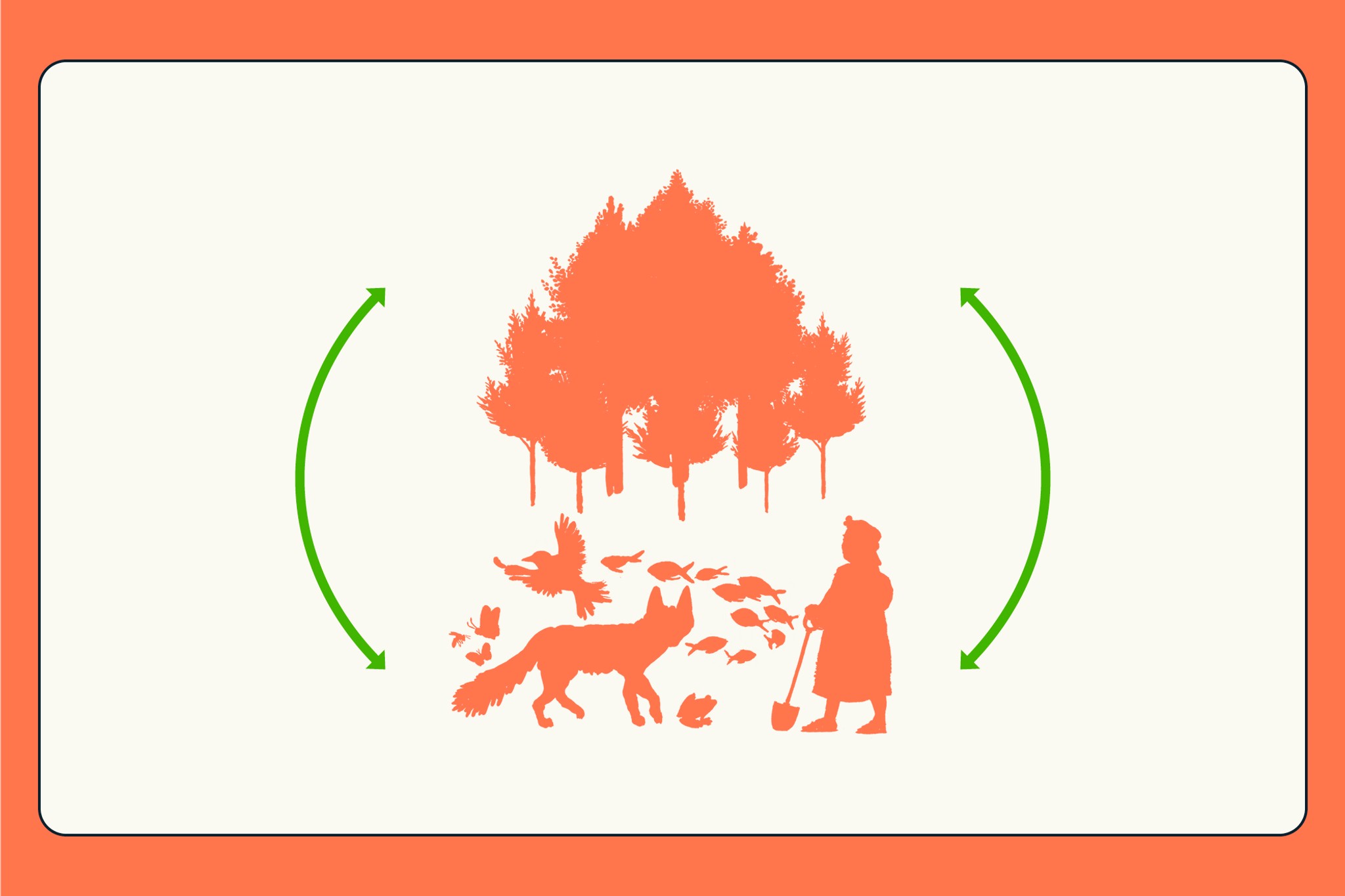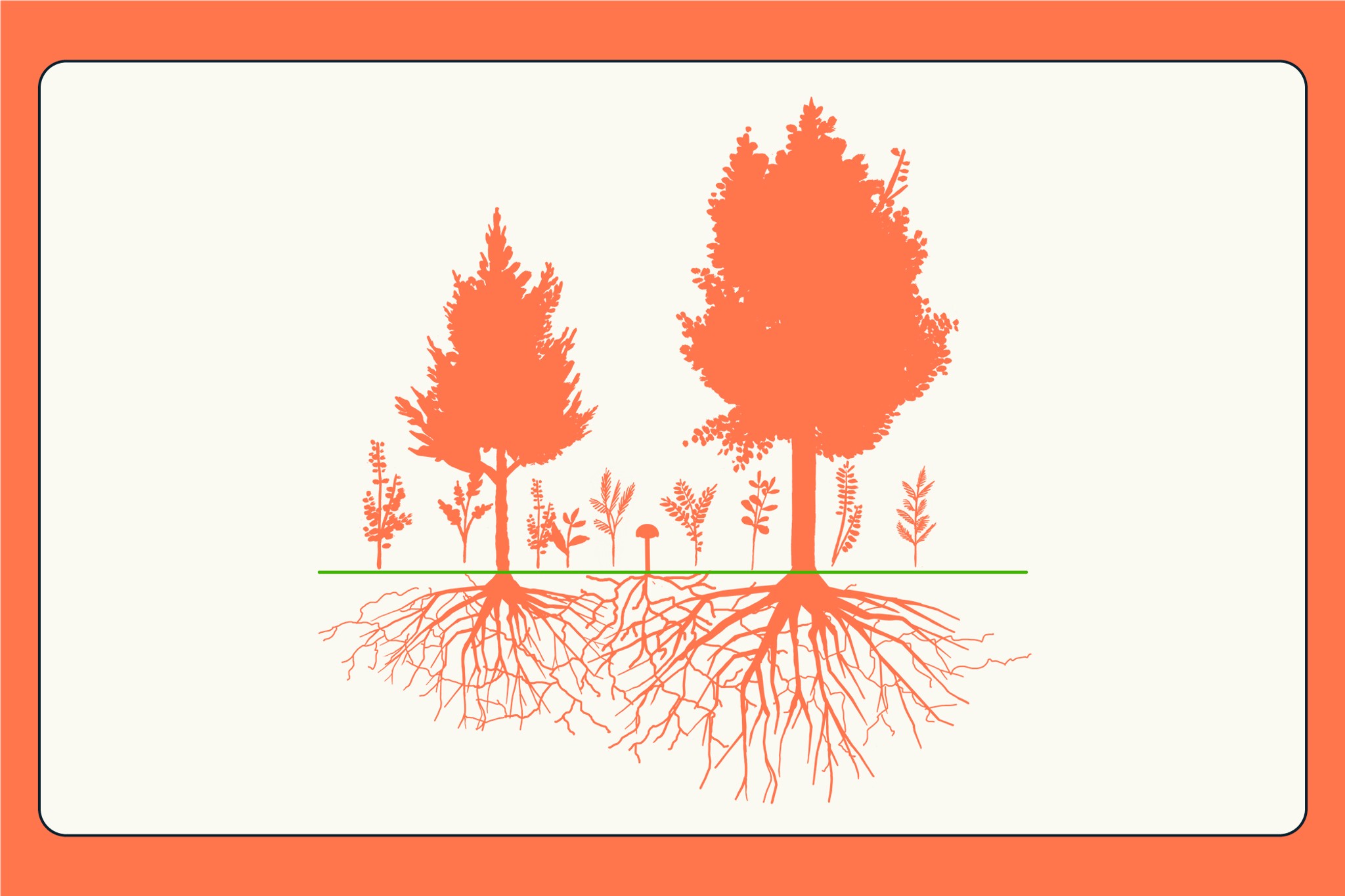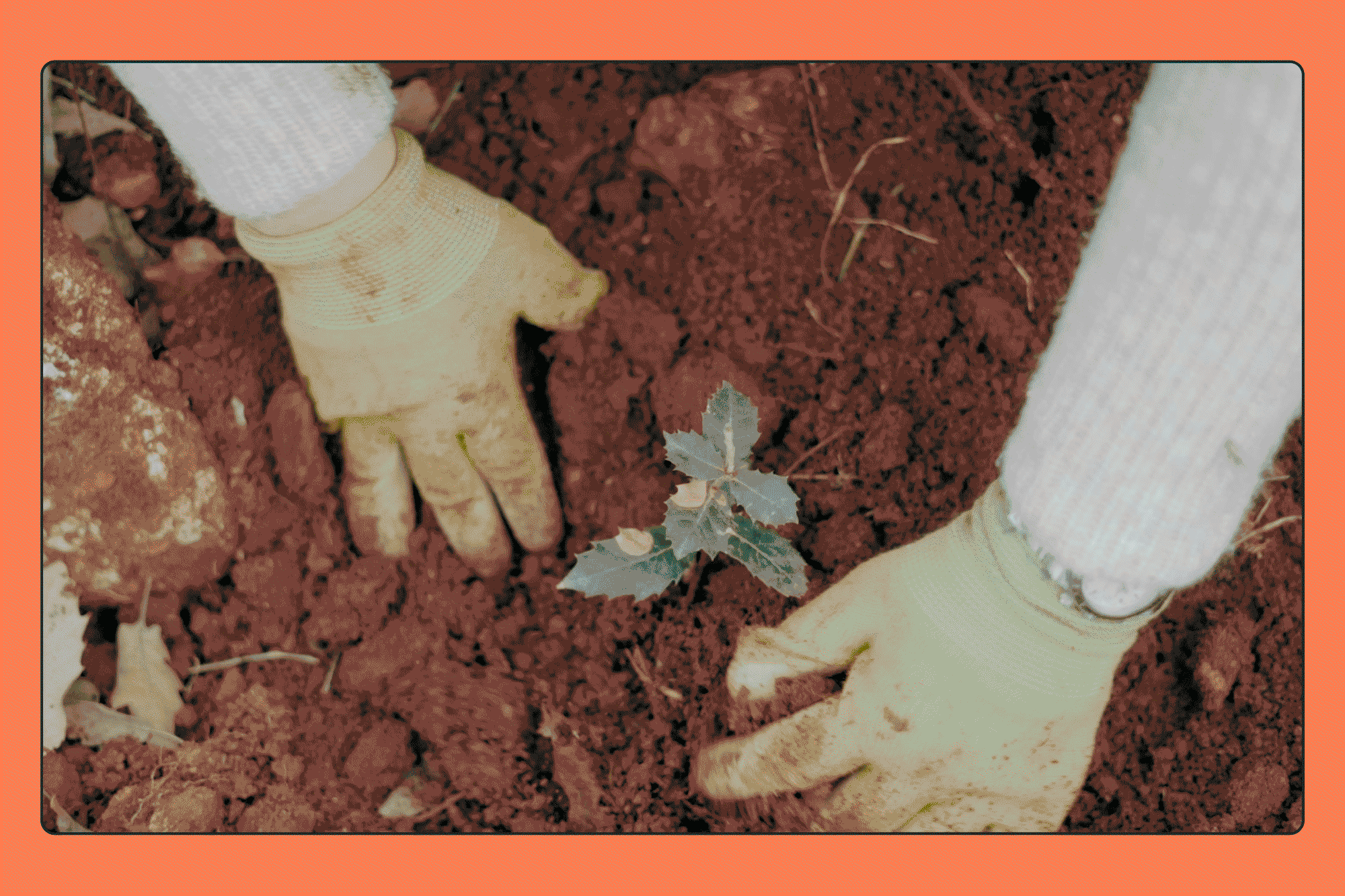Why Do We Need Biodiverse Forest Ecosystems to Combat Climate Change?

Why do we need forests?
Earth’s biodiversity depends upon forests, and the survival of forests depends upon biodiversity.
Forests cover almost a third of the global land area and are home to more than 80% of all terrestrial species. But forests do so much more than provide provisions such as food, water, medicine and shelter for many species – including ourselves.
Forests provide an astonishing range of ecosystem services. A healthy forest ecosystem stores carbon from the atmosphere and regulates the global carbon cycle; it conserves soil and builds soil stability, stabilises stream flow and water run-off, recharges aquifers, stimulates rainfall, regulates the climate and prevents desertification. A fully functioning forest filters water and air pollution and reduces the risk of natural disasters such as drought, floods, landslides and severe wildfires.

Ecosystem services is the term used to describe the natural benefits of the forest for all life; they’re absolutely essential in curbing the effects of climate change as they maintain and regulate a stable environment.
The destruction of these precious ecosystems through pollution, deforestation, over-exploitation, invasive species, biodiversity loss and climate change, and the incessant burning of fossil fuels, is leading to environmental disaster.

But why do we need biodiversity for a forest to be healthy?
Biodiversity is essential for a healthy forest because it’s precisely this interconnected community of plants, animals and microorganisms working together with each other and the non-living elements that create a forest ecosystem in the first place.
Forest ecosystems need biodiversity to flourish because every living thing within that ecosystem fulfils an integral role that enables the forest to thrive.
If species drop out, the forest’s intricate system weakens; without biodiversity, it becomes unbalanced and less resilient to disease and climate change; this results in a negative-feedback loop causing even more biodiversity loss and exacerbating the effects of the climate crisis.
An ecosystem’s non-living and living components work together to create the conditions for all via a variety of physical, chemical and biological events termed ecosystem processes.

There are four most commonly defined ecological processes in ecosystems – these involve constantly recycling the key things we all need to survive – the water cycle, nutrient cycle, energy cycle and succession. Essentially, the living organisms of an ecosystem want to make their home as habitable as possible, so these processes make it a clean, sustainable, functional and resilient place to live.
These underlying processes support the environmental conditions that make all life possible. Without them, other ecosystem services would not be able to happen.
As Enric Sala, National Geographic Explorer-in-Residence comments, “Every morsel of food, every sip of water, the air we breathe is the result of work done by another species.”
The ecosystem processes between the non-living and living things are responsible for the air we breathe, the water we drink, the nutrients and energy we consume, and the environment we exist within.
Biodiversity within an ecosystem does the work to ensure our continued survival.

What role do forests play in the water cycle?
The water cycle is the cyclical journey water takes as it moves from ocean and land to sky and back again in varying states.
The water cycle, along with these other key ecosystem processes, is a supporting ecosystem service. Supporting ecosystem services are the natural processes that sustain ecosystems and allow the other ecosystem services to happen.
We now understand that healthy forest ecosystems are critical in water recycling. The byproducts of this role mean that forests also stabilise stream flow and water run-off, recharge aquifers, stimulate rainfall, regulate and cool the climate, clean water, provide shade and prevent desertification. These natural benefits are better known as regulating ecosystem services and moderate natural phenomena.
Trees and plants pull water from the ground via their roots, carrying it up through the trunk into tiny pores on the underside of the leaves called stomata. Here it changes into water vapour and is released into the atmosphere through evaporation. This process is called transpiration, which accounts for about 10% of the moisture in our atmosphere.
Trees transpire for two reasons, to pump water and minerals into their leaves for photosynthesis and cool themselves down. A giant oak tree transpires a whopping 1600 litres of water per day during the vegetation period.
As a result of transpiration, there’s more water vapour in the surrounding air in forests. The multiple layers of vegetation provide more surface area for evaporation, and rainfall intercepted by the canopy evaporates before it hits the ground. The transpiration via the leaves cools the surrounding area and keeps it hydrated, and the warmer it gets, the more plants transpire.
But transpiration doesn’t just lower temperatures; it also stimulates global rainfall. Traditional Ecological Knowledge has always understood that forests bring rain. Now an expanding body of scientific evidence is catching up to show that forests can make rain locally and hundreds of miles away in the right conditions.

In the Amazon, 50-80% of moisture remains in that ecosystem’s water cycle. The water vapour created through evapotranspiration rises and condenses into clouds, changing from gas to liquid; this triggers atmospheric circulation that begins pulling in moist coastal air and creating more rain.
Trees seed our atmosphere with billions of beneficial terpenes, bacteria and other biological particles a year; these work like magnets to attract invisible atmospheric moisture and allow cloud formation to begin.
“The rain needs forests as much as forests need rain,” explains James Godfrey Faussett, SUGi Forest Maker.
Avissar and Werth showed how deforestation in the Amazon causes a reduction of rain there and in the Western United States and Dakotas in summer. The clouds are carried by winds 100s and 1000s km away.
How do forests manage water flow?
Biodiverse forest ecosystems don’t simply cool the surrounding area through evapotranspiration; they also do it through shading. A dense canopy acts as a shield cooling the ground and bodies of water beneath it. Vegetated areas also reflect more solar radiation away from their surfaces than artificial ones.
The canopy acts as a barrier to stem the flow of rainfall. Leaves and branches intercept the downpour and spread the impact over a more extended period, stabilising water and nutrient run-off, flash floods and stream flow. Where you see deforestation, you’ll find the opposite.
Ultra-dense native forests can also create a green wall in extreme weather disasters, such as floods, tsunamis, storm surges and hurricanes. The barrier slows the force of the current and can also catch drifting debris. Deep roots prevent the trees from falling over.

Decomposing leaf matter forms an organic layer on the forest floor that allows water to permeate the soil like a sponge. More decomposing organic matter means more carbon, and water follows carbon, improving water retention in soil.
The same plant roots that remove groundwater from aquifers also provide the root pathways for rainwater to drain into the soil to recharge the aquifers. The biodiversity of life within forests maintains soil infiltration.
What role do forests play in the carbon cycle?
Healthy forests are a carbon sink, which means they sequester more carbon than they emit. In a world that’s seeing a dangerous imbalance of carbon – protecting, regenerating and creating biodiverse forest ecosystems is a vital tool to avoid further damage.
Carbon is not the criminal; we need it to survive. Carbon is the building block of all life – it’s the backbone of what all living things are made of. However, nature keeps carbon levels balanced, meaning that the amount of carbon released from “reservoirs” equals the amount absorbed by “reservoirs”. We are disturbing the carbon cycle in multiple ways, including releasing carbon through burning fossil fuels.
What role does carbon play in a forest ecosystem?
Forests are the lungs of our planet; they take sunlight, water and carbon dioxide and create energy in the form of sugars and oxygen. This process is called photosynthesis; through it, we get the oxygen we need to breathe, and plants get the fuel they need to grow.
Oxygen-producing photosynthesis functions as a counterbalance to the CO2-producing respiration by all breathing organisms. Rainforests are responsible for roughly 28% of the Earth’s oxygen – marine plants produce 70%.
Photosynthesis plays a vital role in the carbon, nutrient and energy cycle. If photosynthesis stopped, there would soon be little food or other organic matter on Earth, and we’d quickly run out of oxygen.
Carbon from the atmosphere becomes part of a tree’s biomass; it’s used to build the trunk, branches and leaves. These leaves and stems are then digested by animals called primary consumers and used for their own cellular growth. These primary consumers are eaten by secondary and tertiary consumers, and the energy (and carbon) moves through the food web.

How does biodiversity facilitate the nutrient cycle in a forest ecosystem?
But when plants and animals die, those nutrients (including carbon) return to the soil, only to be fed back to the plants. The nutrient and energy cycle begins again. Dead lifeforms fall to the forest floor as organic matter – food for primary and secondary decomposers.
Primary decomposers like fungi and bacteria break down organic and non-organic matter into simple compounds, releasing these nutrients in a plant-available form. Fungi build their bodies from the carbon they ingest and as they grow, their walls get thicker. Undisturbed fungi-dominant soils are huge carbon sinks because fungi lock carbon in their bodies.
Forests’ soils are fungi-dominant. The ratio of fungal to bacterial biomass may be 5:1 to 10:1 in a deciduous forest and 100:1 to 1000:1 in a coniferous forest.
Why is biodiversity in forest soil important?
We now know that forests have a special relationship with mycorrhizal fungi. Mycorrhizal fungi connect the forest through a vast underground Wood Wide Web, enabling trees to communicate and pass resources to each other. Fungi provide the trees with nutrients they mine in return for their sugars.
The relationship between native trees and mycorrhizal fungi also enhances transpiration and photosynthesis. Without diversity of life in the soil, plants would not be able to access the nutrients they need to survive. As a result, neither would we. A biodiverse soil food web keeps the forest healthy.
However, a biodiverse soil food web also builds soil structure. Fungi and bacteria produce glues that enable them to stick together. This action creates space in the soil for water and oxygen to move through; non-compacted soil allows for roots to reach far deeper to get water.
The complex networks of tree roots and soil life present in a healthy forest act to hold soil in place, even on steep hillsides or during heavy rainfall, preventing erosion.

How do biodiverse forests filter pollution?
A biodiverse soil food web purifies water as it passes through the soil profile because any contaminants are seen as nutrients by fungi and bacteria and are consumed by the bodies as water passes.
Trees also absorb airborne toxic chemicals through the pores in their leaves, effectively filtering these chemicals from the air.
SUGi plants biodiverse forest ecosystems to combat climate change
SUGi plant pocket forests in urban areas using the Miyawaki Method. The Miyawaki Method acts as a turbo-booster for ecosystem creation by mirroring and accelerating what nature would do in that geographical area if it were to recolonise itself.
By focusing on building biodiversity and creating resilient ecosystems, SUGi forests provide a range of ecosystem services beyond simply carbon capture. Many of the forests planted offer multiple climate solutions in areas struggling with environmental problems. Often the reason for these environmental problems is green-space loss.
For example, SUGi has ventured into large-scale oak restoration in Athens in response to the tragic loss of forests in the region following devastating fires. The project will restore a complex ecosystem through the planting of an interconnected mix of native species – from the mighty oak down to scented and medicinal herbs.

Planting native species is essential for building biodiversity because these species have co-evolved within that particular ecosystem and have learnt how to maintain and regulate those surroundings. You are planting what should be there. The Athenian Oak Revival will offer an alternative to the pine mono plantations that have come to dominate the local landscape and are highly susceptible to fires.
“Pines have a really high resin content that’s kept in the tree. Fire, resin and oil turn the plantation into piles of ashes.” James Godfrey-Faussett, SUGi Forest Maker
Native oak and olive have adapted to store energy in their large root systems, meaning if they are burnt they tend to have a chance of regenerating. Species such as Cupressus Sempervirens store a lot of water in their needles and the foliage is really tight, meaning airflow is reduced.
Where there is a relationship between native trees and fungi you also see increased decomposition and reduced leaf litter as fuel for fire.




